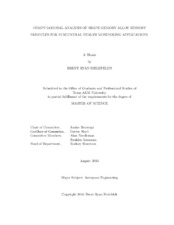| dc.description.abstract | The development of new structural damage detection methods is of great interest to the aerospace industry. Current detection techniques rely on experiences with similar vehicles operating in similar conditions and require disassembly and part-by-part inspection. While effective, these methods can be costly, inefficient, and unnecessary if the aircraft is not in danger of structural failure. It is imagined that future aircraft will utilize non-destructive evaluation methods, allowing for the near real-time monitoring of structural integrity. A particularly interesting method involves utilizing the unique transformation response of shape memory alloy (SMA) particles embedded in an aircraft structure. By detecting changes in the mechanical and/or electromagnetic responses of embedded particles, operators could detect the formation or propagation of fatigue cracks in the vicinity of these particles.
This work seeks to demonstrate the ability of SMA sensory particles to detect structural damage using a computational approach. For the first time, sensory particle response to local damage is demonstrated using finite element modeling. This model, based on an experimental demonstration, allows for the determination of sensory particle material properties by matching experimental data to finite element simulations. The result is then used to predict particle response to a propagating crack in the root rib of an aircraft wing using finite element analysis. In particular, this model utilizes substructure modeling to maintain computational efficiency while relating globally applied loads to local structural response. Finally, this work examines whether sensory particles can be used to approximate the location of structural damage by interpolating a stress field based on the responses of sensory particles in the vicinity of a propagating crack. | en |


